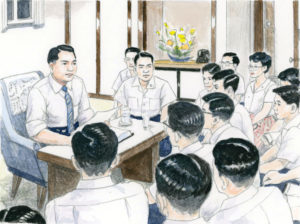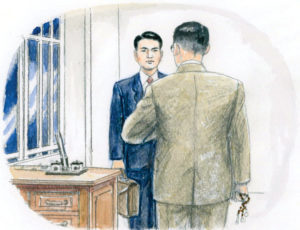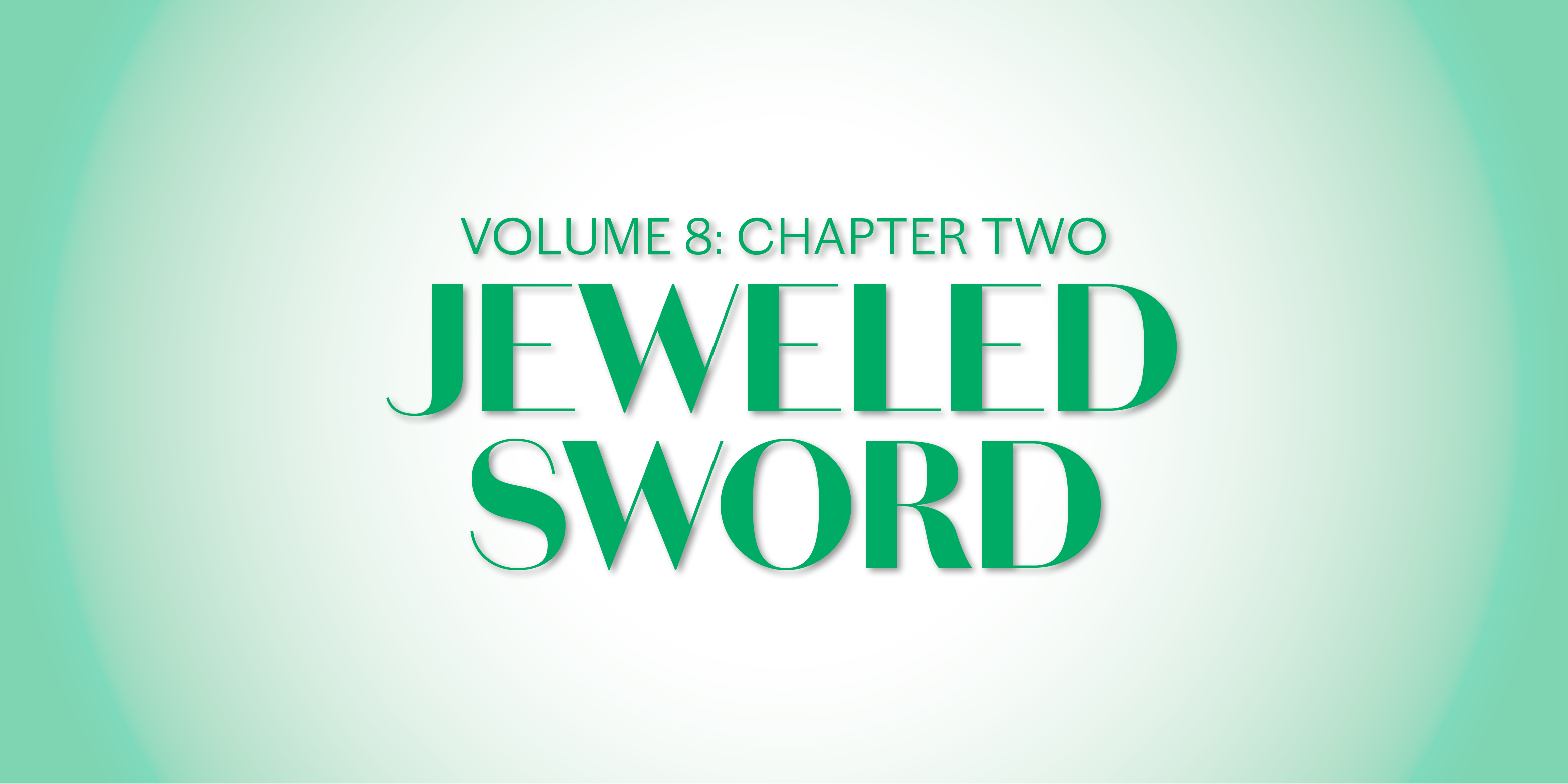Chapter Summary

Illustration courtesy of Seikyo Press.
On July 1, Shin’ichi Yamamoto, at a young men’s leaders meeting, announced that the seventh memorial (sixth anniversary)[1] of Josei Toda’s death on April 2, 1964, would be the start of the essential phase of the Soka Gakkai’s development. By “essential phase,” Shin’ichi meant the time when the actual work of kosen-rufu would begin. At a young women’s leaders meeting on July 5, Shin’ichi suggested that the young women’s and young men’s divisions each aim for a new membership goal of one million. He encouraged those gathered, stating, “I hope that all of you, the members of the young women’s division, will do your best to personally meet with and encourage each member” (The New Human Revolution, vol. 8, p. 90).
The next day, on July 6 in Amagi on the Izu Peninsula in Shizuoka Prefecture, Shin’ichi energetically joined the training sessions for the Suiko-kai and the Kayo-kai—the respective training groups of the young men’s and young women’s divisions. He devoted every ounce of his energy to the education of these youth.
In commemoration of the twelfth anniversary of the founding of the young men’s division on July 11, Shin’ichi penned new guidelines for the youth, titled “Youth, Become World Leaders!” This became a spiritual clarion call that opened the eyes of the youth to the world and urged them to gain awareness as leaders of the world.
In Kansai, he began a lecture series on Nichiren Daishonin’s “One Hundred and Six Comparisons.” He sought to raise and develop each participant of these lectures into a “jeweled sword” for kosen-rufu.
On July 25, the Seikyo Shimbun carried a directive from High Priest Nittatsu, who admonished priests and the members of the Hokkeko (an association of parishioners belonging to various local Nichiren Shoshu temples) for their lack of motivation to work for kosen-rufu, and for criticizing the Soka Gakkai. Shin’ichi also battled the demonic nature of authority that had clothed itself in priestly robes.
Unforgettable Scene

Illustration courtesy of Seikyo Press.
What We Do at the Crucial Moment Determines Victory or Defeat
On July 6, 1963, when Shin’ichi arrived at the Suiko-kai meeting, he gave guidance to the youth leaders about the spirit of selflessly dedicating oneself to spreading the Law.
Shin’ichi continued: “… Later, when [second Soka Gakkai president Josei Toda’s] business reached a desperate impasse, he paid close attention to the reactions of his disciples and watched to see what they would do. He was observing their true nature. What we do, how we act, at the crucial moment is what determines ultimate victory or defeat.
“When Mr. Toda’s business fell into crisis, I was suffering from tuberculosis. I had a persistent fever and sometimes coughed up blood. Our salaries were still suspended, and my co-workers were leaving one after another. Though they were indebted to him in many ways, some criticized Mr. Toda harshly behind his back.
“But I kept working. I had inwardly determined to give my life to Mr. Toda, to fight alongside him and to die spreading Nichiren Daishonin’s teachings while he was still alive. I believed this was the only way to be an example and show what it means to be a true disciple of Mr. Toda and the Daishonin in the present day.
“Mr. Toda understood everything. He knew me completely, inside and out. He said to me: ‘You’re trying to kill yourself, aren’t you? You’ve decided to give me your life. But I will not have it! You must live—live out your life to the fullest. I will give you my life so that you may do so.’ It was a mentor’s passionate cry of concern for his disciple and for the future of our movement. With those words, I strongly resolved to live out my life dedicated to the advancement of kosen-rufu.
“To give one’s life to kosen-rufu and to live one’s life for kosen-rufu are two sides of the same coin. One is not different from the other. Both include the spirit to devote one’s life to propagating the Mystic Law.
“Why am I telling you, the Suiko-kai members, these things? It is because you represent the youth who have been entrusted with the mission of accomplishing the worldwide spread of Buddhism.”
This guidance carried profound significance for the youthful leaders. Eisuke Akizuki and the others acutely sensed that Shin’ichi was pouring all his energy into the Suiko-kai. (NHR-8, 95–97)
Key Passage
Meetings are of course important, but in reality not everyone can attend them. There are usually at least twice as many members in a local organization as the number who regularly participate in any given discussion meeting. Only by personally visiting and encouraging each member in our area can we solidify our organization. This will lead to the Soka Gakkai’s growth and development, and in turn, to the advancement of kosen-rufu. (NHR-8, 90)
References
- According to Japanese tradition, the first memorial service is held immediately after a person’s death, that is, the funeral memorial service. The second memorial service is held upon the first anniversary of that occasion and so on. ↩︎
You are reading {{ meterCount }} of {{ meterMax }} free premium articles

